According to many experts, chronic prostatitis is an inflammatory disease caused by infection with the possible addition of autoimmune diseases and characterized by damage to the parenchymal and interstitial tissues of the organ. The disease has been known to medicine since 1850, but is still poorly understood and is difficult to treat. Chronic bacterial (6-10%) and non-bacterial (80-90%) prostatitis are the most common and socially significant inflammatory diseases in men, which significantly reduce their quality of life. The disease is observed mainly in young and middle-aged people and is often complicated by impaired copulative and generative functions (decreased potency, infertility, etc. ). The disease is found in 8-35% of cases in men between the ages of 20 and 40.
The cause of bacterial prostatitis is the pyogenic flora that enters the gland from the urethra or via the lymphogenic and hematogenic pathways. The etiology of chronic non-bacterial prostatitis and its pathogenesis are still unknown. Men over 50 years of age are particularly affected.
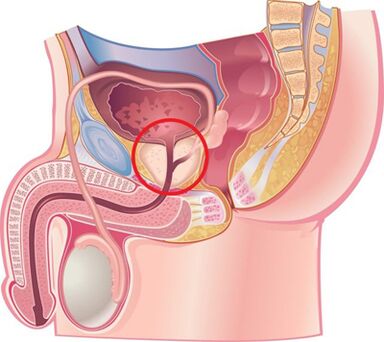
The reasons for the development of the disease
Chronic prostatitis is currently considered a polietiological disease. There is an opinion that the disease arises from the penetration of an infection into the prostate, and then the pathological process progresses without its involvement. A number of non-infectious factors contribute to this.
Infectious factors in the development of chronic prostatitis
In 90% of cases, pathogens enter the gland via the urethra, which leads to acute or chronic prostatitis. There have been cases of asymptomatic promotion. The course of the disease is influenced by the state of the human immune system and the biological properties of the pathogen. It is believed that the transition from acute to chronic prostatitis occurs due to loss of tissue elasticity due to excessive production of fibrous tissue.
The pathogens that cause chronic prostatitis include the following:
- In 90% of cases, the disease shows gram-negative bacteria such as Escherichia coli (E. coli), Enterococcus faecalis (Enterococcus in the stool), somewhat less often - Pseudomonas aeruginosa, Klebsiella spp. , Proteus spp. , Pseudomonas aeruginogenes and Enterobactero. Gram-positive bacteria enterococci, streptococci, and staphylococci are rare.
- The role of coagulase-negative staphylococci, ureaplasma, chlamydia, Trichomonas, Gardnerella, anaerobic bacteria and fungi of the genus Candida is not fully understood.
The infection enters the prostate in several ways:
- Most likely, it is an ascending route, as the common combination of prostatitis and urethritis shows.
- Hematogenous prostatitis develops when the infection enters the gland with the bloodstream, which is observed with chronic tonsillitis, sinusitis, periodontitis, pneumonia, cholecystitis and cholangitis, purulent skin diseases, etc.
- Chronic prostatitis with urethritis and strictures of the urethra develops through contact, if the infection enters the gland with the flow of urine ascending, in purulent infections of the kidneys, by the canalicular route in epipidymitis, deferentitis and funiculitis, during diagnostic and therapeutic urological manipulations (catheterization, Urethralization), including transurethral.
- Lymphogenic infection penetrates the prostate with proctitis, thrombophlebitis of the hemorrhoidal veins, etc.

Non-infectious factors in the development of chronic prostatitis
Chemical factors
According to experts, the leading role in the development of chronic prostatitis is played by intraprostatic reflux of urine, when urine is thrown from the urethra into the gland, which leads to impaired emptying of the prostate and seminal vesicles.
With the disease, vascular reactions develop, which lead to edema of the organ, the nervous and humoral regulation of the tone of the smooth muscles of the urethra is disturbed, the activation of alphaone–Adrenergic receptors cause the development of dynamic obstruction and contribute to the development of new intraprostatic reflux episodes.
The urates contained in the urine lead to the development of a "chemical inflammatory reaction" with reflux.
Hemodynamic disorders
They support chronic inflammation and circulatory disorders of the pelvic organs and the scrotum. Traffic jams develop in people who lead a sedentary lifestyle, such as drivers, office workers, etc. , with obesity, sexual abstinence, sexual dysmetria, frequent hypothermia, mental and physical overload. Consumption of spicy and spicy foods, alcohol and smoking, etc. help maintain the inflammatory process.
Other factors
There are many other factors that contribute to chronic prostate inflammation. These include:
- Hormonal.
- Biochemically.
- Impaired immune response.
- Autoimmune mechanisms.
- Infectious and allergic processes.
- Features of the structure of the prostate glands that lead to difficulties in complete drainage.
Often the reasons for the development of chronic prostatitis cannot be established.
Classification of prostatitis
According to the classification proposed by the US National Institutes of Health in 1995, prostatitis is divided into:
- Acute (Category I). Is 5 - 10%.
- Chronic bacteria (Category II). Is 6-10%.
- Chronic non-bacterial inflammation (Category IIIA). Is 80 - 90%.
- Chronic non-bacterial non-inflammatory (Category IIIB) or chronic pelvic pain syndrome.
- Chronic prostatitis, diagnosed by chance (Category IV).
Signs and symptoms of chronic prostatitis
The course of chronic prostatitis is long but not monotonous. The phases of exacerbation are replaced by phases of relative rest that occur after complex anti-inflammatory and antibacterial therapy.
The development of chronic bacterial prostatitis is often preceded by bacterial or gonorrheic urethritis, non-bacterial circulatory disorders of the pelvic organs and scrotum (hemorrhoids, varicocells, etc. ), sexual excesses.
Patients with chronic prostatitis have many complaints. They go to doctors for years but are very rarely checked for prostate disease. About a quarter of the patients show no symptoms or the disease progresses with few clinical symptoms.
Complaints from patients with chronic prostatitis can conditionally be divided into several groups.
Urinary tract disorders related to narrowing of the urethra:
- Difficulty starting to urinate.
- Weak urine stream.
- Intermittent or drop-wise urination.
- Feeling of incomplete emptying of the bladder.
Symptoms from irritation of the nerve endings:
- Frequent urination.
- The urge to urinate is sharp and violent.
- Urinating in small portions.
- Urinary incontinence during the urge to urinate.
Pain syndrome:
- The intensity and type of pain are different.
- Localization of pain: lower abdomen, perineum, rectum, groin and lower back, inner thighs.
Sexual dysfunction:
- Pain in the rectum and urethra when ejaculating.
- Sluggish erection.
- Loss of orgasm.
- Premature ejaculation, etc.
On the part of the nervous system: neurotic disorders in the form of the patient's attention to his state of health.
Signs and symptoms of chronic non-bacterial prostatitis
The syndrome of chronic pelvic pain in men (CPPS) occurs with the usual symptoms of chronic prostatitis, but bacteria are absent in the third part of the urine and in the secretion of the prostate. CPPS can be simulated by chronic non-bacterial interstitial cystitis, rectal disease, spastic pelvic floor myalgia, and functional prostate lesions due to disturbances in the innervation of the organ and its hemodynamics.
If neurovegetative function is impaired, atony and a violation of the innervation of the gland are noted, which is manifested in the difficulty of quickly and completely closing the lumen of the urethra. At the same time, the urine is excreted drop by drop for a long time after urination. In such patients, the study shows instability and increased excitability, which is manifested by increased sweating and excitability of cardiac activity, changes in dermographism.
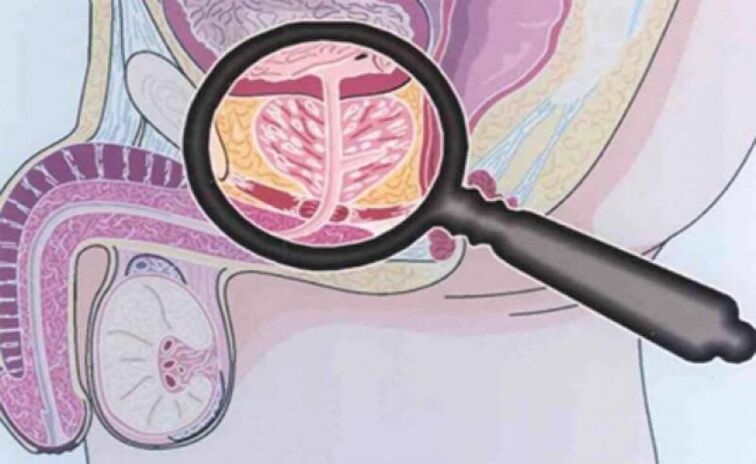
Complications of the disease
The long course of chronic prostatitis is complicated by impaired sexual and reproductive functions, the development of diseases such as vesiculitis and epipidymitis, as well as hardening of the organ. Sclerosis of the organ worsens local microcirculation and urodynamics, as well as the results of surgical interventions. Fibrosis of the periurethral tissue leads to the development of urinary tract diseases.
diagnosis
Since there are many reasons for developing chronic prostatitis, a whole range of diagnostic studies are used to diagnose it. The success of the treatment depends on the correct determination of the causes of the disease. The diagnosis of chronic prostatitis is based on the following data:
- The classic triad of symptoms.
- A number of physical methods (digital rectal examination of the prostate).
- A number of laboratory methods (urinalysis and microscopy of prostate secretion, culture and determination of the sensitivity of the microflora to antibacterial drugs, general analysis of urine and blood).
- For the detection of gonococci, bacterioscopy of a swab from the urethra, PCR and serological methods (for the detection of ureaplasma and chlamydia).
- Urofluorometry.
- Prostate biopsy.
- Complex of instrumental methods (ultrasound).
- Determination of the patient's immune status.
- Determination of the neurological status.
- If treatment is ineffective and complications are suspected, computer and magnetic resonance imaging, blood culture, etc.
Palpation of the prostate
Of paramount importance in diagnosing the disease is palpation of the prostate, which increases during the period of exacerbation and decreases as the inflammatory process subsides. In chronic prostatitis during iron exacerbation, it is edematous and painful.
The density of the consistency of the organ can be different: areas of softening and compression are palpated, zones of depressions are determined. During palpation, it is possible to assess the shape of the gland, the condition of the seed cusps and surrounding tissues.
The process of the transrectal digital examination is combined with the collection of the glandular secretion. Sometimes it is necessary to get the secret of each share separately.
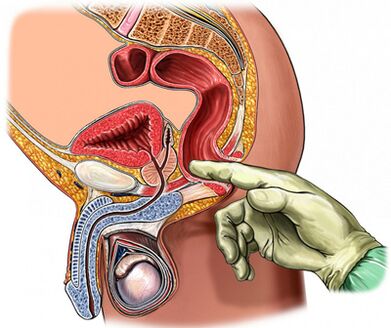
Analysis of a 3-glass urine sample and prostate secretion
The "gold standard" in the diagnosis of chronic prostatitis are:
- Collection of the first portion of urine.
- Collection of the second amount of urine.
- Extraction of the secretion of the gland by massage.
- Collection of the third portion of urine.
Furthermore, a microscopic and bacteriological examination of the material is carried out.
For prostate inflammation:
- Microbe count (CFU) exceeds 103/ ml (10four/ ml for epidermal staphylococci), but do not neglect the small number of microbes in the tens and hundreds.
- The microscopically proven presence of 10-15 leukocytes in the field of vision is a generally accepted criterion for the presence of an inflammatory process.
The secret of the prostate and the 3rd portion of urine are examined microscopically and bacteriologically:
- With chronic bacterial prostatitis, there is an increase in the number of leukocytes in the secretion of the gland, and bacteria (mainly of the intestinal group) are released in the third portion of urine after the massage.
- With non-bacterial prostatitis, the number of leukocytes in the secretion of the gland increases, but the microflora is not detected.
- With CPPS there is no increased number of leukocytes and microflora.
Normal rate of prostate secretion:
- White blood cells less than 10 in the field of view.
- There are many grains of lecithin.
- Microflora is absent.
With chronic prostatitis, the secretion of the prostate shows:
- The number of leukocytes is large - more than 10-15 in the field of vision.
- The amount of lecithin grains is reduced.
- The pH of the secretion shifts to the alkaline side.
- The acid phosphatase content is reduced.
- The activity of lysozyme is increased.
Receiving negative results in prostate secretion does not even prove the absence of an inflammatory process.
The value of the prostate secretion crystallization test is retained. Normally a characteristic pattern in the form of a fern leaf forms during crystallization. With a violation of the aggregation properties of the prostatic secretion, such a pattern is not formed, which occurs when the androgenic hormonal background changes.
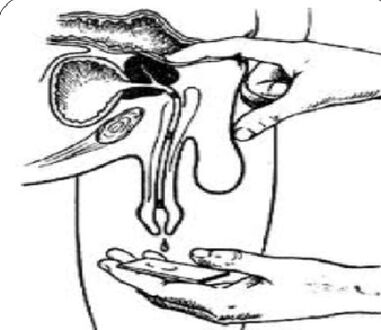
Ultrasonic method
If a prostate disease is suspected, an ultrasound examination of the gland itself (optimally transrectal ultrasound), the kidneys and the bladder is used, which can determine:
- The volume and size of the gland.
- Presence of calculi.
- The size of the seminal vesicles.
- The condition of the walls of the bladder.
- The remaining amount of urine.
- Scrotum structures.
- Another type of pathology.
Other methods of examining the prostate
- The state of urodynamics (an examination of the flow rate of urine) can be easily and simply determined with an examination such as uroflowmetry. With the help of this study, it is possible to identify signs of a bladder outlet obstruction at an early stage and to carry out dynamic observation.
- If abscess formation, benign hyperplasia, or prostate cancer are suspected, a puncture biopsy is performed.
- To clarify the reasons for the development of an infravesicular obstruction, X-ray and endoscopic examinations are performed.
- With a long-term inflammatory process, urethrocystoscopy is recommended.
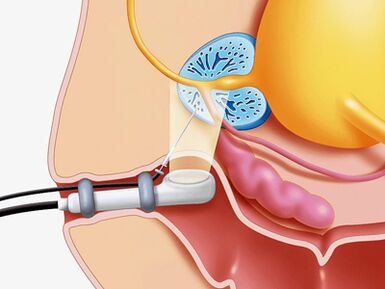
Differential diagnosis
Chronic prostatitis should be differentiated from vesiculoprostatostasis, autonomic prostatopathy, congestive prostatitis, pelvic floor myalgia, neuropsychiatric diseases, pseudodyssynergy, reflex sympathetic dystrophy, inflammatory diseases of other organs: interstitial cystitis, ostate ostitis of the vesicular hyperthyroidism, prostatic hyperthyroidism, cancer, prostate.
Treatment of chronic prostatitis
Treatment for chronic prostatitis should begin with a change in the patient's lifestyle and diet.
In the treatment of the disease, drugs that affect various pathogenesis compounds are used at the same time.
The most important therapy directions:
- Elimination of the causing microorganisms.
- Anti-inflammatory therapy.
- Normalization of blood flow to the prostate and pelvic organs.
- Normalization of adequate drainage of the prostate acini.
- Normalization of the hormonal profile.
- Prevention of hardening of the organ.
To treat chronic prostatitis, drugs of the following groups are used:
- Antibacterial.
- Anticholinergic.
- Vasodilators.
- alphaone–Adrenergic blockers.
- 5 alpha reductase inhibitors.
- Cytokine inhibitors.
- Nonsteroidal Anti-Inflammatory.
- Angioprotectors.
- Immunomodulators.
- Drugs that affect urate metabolism.
Antibiotics used to treat chronic bacterial prostatitis
Antibiotic therapy should be carried out taking into account the sensitivity of the identified microorganisms to antibiotics. If the pathogen is not identified, empirical antimicrobial treatment is used.
The drugs of choice are II-IV generation fluoroquinolones. Using the usual methods of application, they quickly penetrate the tissue of the gland, act against a large group of gram-negative microorganisms, as well as ureaplasma and chlamydia. If antimicrobial treatment fails, assume:
- Multi-resistance of the microflora,
- short (less than 4 weeks) treatment courses,
- wrong choice of antibiotic and its dosage,
- Changes in the nature of the pathogen,
- the presence of bacteria living in the ducts of the prostate, which are covered with a protective extracellular membrane.
The duration of treatment should be at least 4 weeks with an obligatory subsequent bacteriological control. If there are more than 10 bacteriurias in the 3rd part of the urine and prostate secretion3CFU / ml, repeated antibiotic therapy, is prescribed for a period of 2 to 4 weeks.
Cytokine inhibitors in the treatment of chronic prostatitis
Cytokines are glycoproteins that are secreted by immune and other cells in response to an inflammatory response and an immune response. They actively take part in the development of the chronic inflammatory process.
Non-steroidal anti-inflammatory drugs
Nonsteroidal anti-inflammatory drugs have anti-inflammatory effects, relieve pain and fever. They are widely used in the treatment of chronic prostatitis in the form of tablets and suppositories. The most effective way is by rectal administration.
Immunotherapy
In the treatment of bacterial chronic prostatitis, in addition to antibiotics and anti-inflammatory drugs, immunomodulatory agents are used. The rectal route of their administration is most effective. An immunomodulator that increases the functional activity of phagocytes, which contributes to a more efficient elimination of pathogens, is widely used.
Alpha blockers in the treatment of chronic prostatitis
Alpha-1 adrenergic blockers have been found to normalize the tone of the smooth muscles of the prostatic urethra, seminal vesicles and prostate capsule, which makes the drugs of this group very effective in treating the disease. Alpha-1 adrenergic blockers are used in patients with severe urinary tract diseases without an active inflammatory process.
For CPPS, the duration of treatment is 1 to 6 months.
5a-reductase inhibitor in the treatment of abacterial prostatitis and CPPS
It has been found that under the influence of the 5a-reductase enzyme, testosterone is converted into the prostate form 5a-dihydrotestosterone, the activity of which in prostate cells is more than 5 times higher than the activity of testosterone itself, which leads to a in the elderlyIncrease in the organ due to epithelial and stromal components.
When taking a 5a-reductase inhibitor for 3 months, atrophy of the stromal tissue is detected within 6 months - glandular function, the secretion function is inhibited, the severity of the pain syndrome and the volume of the glands decrease, the tension and edema of the organ decrease.
The role of anti-sclerotics in the treatment of chronic prostatitis
With prolonged inflammation in the prostate, fibrosis develops, which manifests itself in impaired microcirculation and urodynamics. To prevent the process of fibrosis, anti-sclerotics are used.
Other drugs used to treat chronic prostatitis
In addition to the drugs described above, to treat the disease are used:
- Antihistamines.
- Vasodilators and angioprotectors.
- Immunosuppressants.
- Medicines that affect the metabolism of urate and trisodium salt of citric acid.
Herbal products
Effective in the treatment of prostatitis is the use of a preparation in the form of suppositories containing a complex of biologically active peptides isolated from the prostate of bovine animals.
Under the influence of the drug occurs:
- Stimulation of metabolic processes in the tissues of the gland.
- Improve microcirculation.
- Reduction of edema, leukocyte infiltration, secretion stagnation and pain.
- Prevention of thrombosis in the venules of the prostate.
- Increased acini secretory epithelium activity.
- Improvement of sexual function (increase in libido, restoration of erectile function and normalization of spermatogenesis).
Finger massage of the prostate
A number of researchers argue that finger massage should be used in chronic prostatitis, taking into account known contraindications.
physical therapy
The effectiveness of physiotherapeutic methods in the treatment of prostatitis has not been proven today, the mechanism of action has not been scientifically proven, and side effects have not been investigated.
Prevention of chronic prostatitis
If you are starting to prevent chronic prostatitis from developing, you should know:
- The risk of developing the disease increases over the years.
- Representatives of the Negroid breed are more susceptible to disease.
- A family predisposition for the disease cannot be ruled out.
Individuals predisposed to developing chronic prostatitis should pay attention to their state of health.
Tips for disease prevention:
- Drink enough fluids. Frequent urination promotes the washing out of the microflora from the urethra.
- Prevent diarrhea and constipation.
- Eat a balanced diet. Avoid foods that are high in carbohydrates and saturated fats, which leads to weight gain.
- You should limit the use of substances that irritate the urethra as much as possible: spicy and spicy foods, smoked meats, sauces and spices, coffee and alcohol.
- Stop smoking. Nicotine adversely affects the condition of the vessel walls.
- Don't overcool.
- Do not stop emptying the bladder.
- Live an active lifestyle, exercise. Exercise to strengthen the pelvic floor muscles, which can clear venous congestion, which in turn supports normal prostate function.
- Have a regular sex life. Avoid prolonged abstinence. The gland must be released from the secret immediately.
- Stay in a monogamous relationship. Arbitrary sex increases the chances of developing sexually transmitted diseases.
- If you have problems with the urogenital organs, contact your urologist immediately.



























